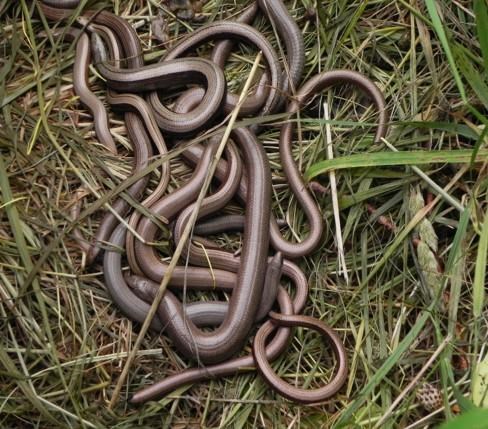
Cumbrian zoologist identifies a first for slow worm conservation
A zoology student from the University of Cumbria is using an ingenious technique to identify individual slow worms as part of her dissertation research into conserving this seldom seen lizard.
Suzanne Collinson,45, a third year BSc (Hons) Zoology student at the University of Cumbria has a passion for the UK’s only legless lizard and is working on a conservation project in the village of Dalston, Carlisle, one of the few areas in Cumbria where the creatures are known to reside.
To help her monitor the population in St Michael’s churchyard in the village, Suzanne is using a novel method of photographing the markings on the animals’ chins. These markings are unique and assist Suzanne in identifying individuals, which are otherwise indistinguishable from each other.
Her conservation work is making an important contribution to the village’s entry into ‘Britain in Bloom 2018’, which saw competition judges visit the village earlier in the month and bestow particular praise on Suzanne’s work.
“The slow worm conservation area in St Michael’s churchyard in Dalston is an important site. The village community is very keen to see the interest taken by the University of Cumbria through the work of Zoology student Suzanne Collinson. This is of great interest to the judges in both competitions” said Mr Ronnie Auld, Dalston in Bloom Chairman and Parish Councillor.
Suzanne has been working on the site for two years and has carried out two population counts: one in summer 2017 and one this year, where she identified 36 unique individuals.
The slow worm is a legless lizard native to Great Britain, which has a sporadic distribution in the North of England. It is listed as a UK Biodiversity Action Plan (BAP) priority species and is protected under the Wildlife and Countryside Act 1981, due to a decline in numbers related to habitat loss. There are recorded populations in the south Cumbria, but very few in the north.
“Slow worms are amazing creatures that live in our midst but are hardly ever seen. The population I am studying was first identified in the 1950s and thought to be brought to the site in bags of compost by allotment holders. They haven’t migrated anywhere else, and it is the only site we know of near Carlisle where they can be found”, said Suzanne. She continued: “they are quite different to your typical creature that tends to be conserved, but I would argue that they are just as important.”
Much of Suzanne’s work involves ensuring the habitat in the churchyard is optimised to support population growth. This involves leaving the grass in the area undisturbed and ensuring there is enough shelter and food so as not to upset the ecosystem in which they thrive.
“I’d really like to encourage people to look out for the creatures in their gardens and report any sightings to the Cumbria Biodiversity Data Centre. Slow worms thrive when left alone so people can encourage them to their garden by leaving a rough area untouched.”
Suzanne reminds people that the slow worms at Dalston move freely through a site and have the tendency to shed their tails in defence if they feel threatened. Due to this possibility, people are asked not walk through the conservation area or to handle them if they seem them.
Suzanne started the study as part of her Zoology degree dissertation, but she hopes her research will be taken up and developed by future students when she finishes her degree.
Suzanne chose to study to become a zoologist after a 20 year career as a beauty therapist. But after being diagnosed with a chronic health condition and once she had recovered, she decided to take her career in a new direction.
Anyone who spots a slow worm can report its sighting to the Cumbria Biodiversity data centre based adjacent to Tullie House.
The village of Dalston will find out if their latest ‘Britain in Bloom’ bid is successful in October.
Dalston has entered ‘Cumbria in Bloom’ competitions for many years and has enjoyed a very successful record. In 2016 the community was asked to represent Cumbria in the ‘large village’ section of the national ‘Britain in Bloom’ competition, and then again in 2017.
A high proportion of the marks awarded by the judges from the Royal Horticultural Society are for environmental projects and awareness. The village’s success in these competitions is down to a series of sustainable environmental projects such as conservation areas, wildflower meadows and Suzanne’s slow worms.
Photo captions: 1. a gathering of slow worms 2. Slow worm 3. Suzanne in Dalston Churchyard with a slow worm.
